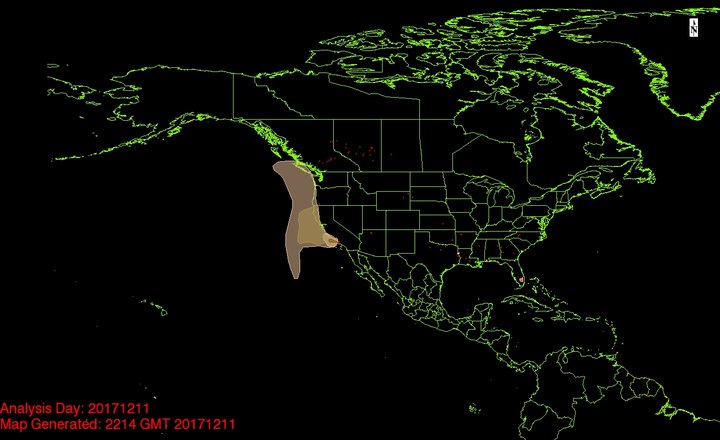
“Current HMS Fire and Smoke Analysis,” National Oceanic and Atmospheric Administration.
###
PREVIOUSLY:
###
So, yeah — you guys were right. The North Coast Unified Air Quality Management District has reversed course since this morning and declared that the smoke that continues to linger over the Humboldt Bay Area does, in fact, originate from the Southern California wildfires.
Richard Lam, a forecaster with the National Weather Service office on Woodley Island, tells the Outpost that the a high pressure area is building off the coast, and should clear the skies by midweek. “It will push all of the smoke in our area to the south again,” Lam said.
Public service announcement from the North Coast Unified Air Quality Management District:
Current winds have brought smoke from fires in Southern California to the North Coast (Trinidad southward) and inland Humboldt and Trinity County. This impact may hold for the next 24 hours until the arrival of a Northwest wind Tuesday night which is anticipated to end the smoke intrusion. However, the continued inversion conditions associated with the current good weather will continue to limit any smoke dispersion keeping emissions in the breathing zone.
Air quality in these areas are still forecast to be in the Good to Moderate with the possibility for “Unhealthy for Sensitive Groups” in the late evening and early morning hours.
Fire information can be found at http://inciweb.nwcg.gov/ or at www.calfire.ca.gov. Current weather information can be found at www.wrh.noaa.gov.
Health Information for Smoke Impacts
Concentrations of smoke may vary depending upon location, weather, and distance from the fire. Smoke from wildfires and structure fires contain harmful chemicals that can affect your health. Smoke can cause eye and throat irritation, coughing, and difficulty breathing.
People who are at greatest risk of experiencing symptoms due to smoke include: those with respiratory disease (such as asthma), those with heart disease, young children, and older adults.These sensitive populations should stay indoors and avoid prolonged activity. All others should limit prolonged or heavy activity and time spent outdoors. Even healthy adults can be affected by smoke. Seek medical help if you have symptoms that worsen or become severe.
If you can see, taste, or feel smoke, contact your local health department and/or primary healthcare provider. This is especially important if you have health concerns, are elderly, are pregnant, or have a child in your care.Follow these general precautions to protect your health during a smoke event:
- Minimize or stop outdoor activities, especially exercise
- Stay indoors with windows and doors closed as much as possible
- Do not run fans that bring smoky outdoor air inside – examples include swampcoolers, whole-house fans, and fresh air ventilation systems
- Run your air-conditioner only if it does not bring smoke in from the outdoors. Change the standard air conditioner filter to a medium or high efficiency filter. If available, use the “re-circulate” or “recycle” setting on the unit
- Do not smoke, fry food, or do other things that will create indoor air pollution
- If you have lung disease (including asthma) or heart disease, closely monitor your health and contact your doctor if you have symptoms that worsen.
- Consider leaving the area until smoke conditions improve if you have repeated coughing, shortness of breath, difficulty breathing, wheezing, chest tightness or pain, palpitations, nausea, unusual fatigue, lightheadedness.
For 24-hour Air Quality Advisory Information, call toll-free at
1-866-BURN-DAY (1-866-287-6329).For further information, visit the District’s website at www.ncuaqmd.org
CLICK TO MANAGE